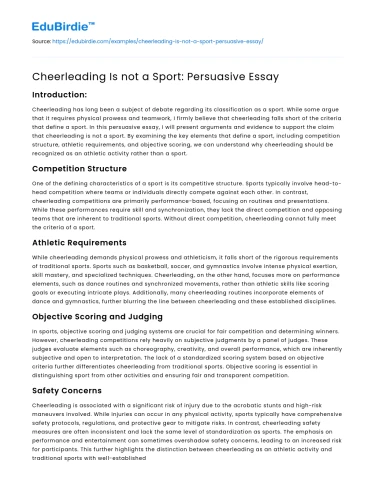Introduction:
Cheerleading has long been a subject of debate regarding its classification as a sport. While some argue that it requires physical prowess and teamwork, I firmly believe that cheerleading falls short of the criteria that define a sport. In this persuasive essay, I will present arguments and evidence to support the claim that cheerleading is not a sport. By examining the key elements that define a sport, including competition structure, athletic requirements, and objective scoring, we can understand why cheerleading should be recognized as an athletic activity rather than a sport.
Competition Structure
One of the defining characteristics of a sport is its competitive structure. Sports typically involve head-to-head competition where teams or individuals directly compete against each other. In contrast, cheerleading competitions are primarily performance-based, focusing on routines and presentations. While these performances require skill and synchronization, they lack the direct competition and opposing teams that are inherent to traditional sports. Without direct competition, cheerleading cannot fully meet the criteria of a sport.
Save your time!
We can take care of your essay
- Proper editing and formatting
- Free revision, title page, and bibliography
- Flexible prices and money-back guarantee
Athletic Requirements
While cheerleading demands physical prowess and athleticism, it falls short of the rigorous requirements of traditional sports. Sports such as basketball, soccer, and gymnastics involve intense physical exertion, skill mastery, and specialized techniques. Cheerleading, on the other hand, focuses more on performance elements, such as dance routines and synchronized movements, rather than athletic skills like scoring goals or executing intricate plays. Additionally, many cheerleading routines incorporate elements of dance and gymnastics, further blurring the line between cheerleading and these established disciplines.
Objective Scoring and Judging
In sports, objective scoring and judging systems are crucial for fair competition and determining winners. However, cheerleading competitions rely heavily on subjective judgments by a panel of judges. These judges evaluate elements such as choreography, creativity, and overall performance, which are inherently subjective and open to interpretation. The lack of a standardized scoring system based on objective criteria further differentiates cheerleading from traditional sports. Objective scoring is essential in distinguishing sport from other activities and ensuring fair and transparent competition.
Safety Concerns
Cheerleading is associated with a significant risk of injury due to the acrobatic stunts and high-risk maneuvers involved. While injuries can occur in any physical activity, sports typically have comprehensive safety protocols, regulations, and protective gear to mitigate risks. In contrast, cheerleading safety measures are often inconsistent and lack the same level of standardization as sports. The emphasis on performance and entertainment can sometimes overshadow safety concerns, leading to an increased risk for participants. This further highlights the distinction between cheerleading as an athletic activity and traditional sports with well-established safety protocols.
Counterarguments and Rebuttals
Some proponents argue that cheerleading meets the criteria of a sport due to its physical demands, athleticism, and competitive nature. However, it is important to recognize that while cheerleading involves physicality, it lacks the core elements that define a sport, such as head-to-head competition and objective scoring systems.
Conclusion
While cheerleading requires athleticism, teamwork, and dedication, it does not fully meet the criteria to be classified as a sport. Its emphasis on performance, lack of direct competition, subjective judging, and inconsistent safety measures distinguish it from traditional sports. Recognizing cheerleading as an athletic activity rather than a sport does not diminish its value or the skill of its participants. It is important to appreciate and celebrate cheerleading for its unique qualities and contributions while acknowledging its distinct nature from traditional sports.






 Stuck on your essay?
Stuck on your essay?

